Most popular varieties
There is a wide variety of varieties of lilies, which differ in the shape of the flowers, their color, the size of the stems, the presence of aroma
Marlene
It is a hybrid variety of the Asiatic lily. Differs in unpretentious cultivation. The stem can grow up to 120 cm. The diameter of the flower can reach 15 cm. The flower has a pale pink color, its center is slightly paler.
Marlene
An unusual feature of the variety - more than a hundred buds can grow on one plant. This phenomenon in science is called fasciation. Marlene is not the only cultivar to have over 100 buds per plant, but it is considered the most spectacular of them all.
In order for all the buds to grow and bloom, it is necessary to provide the plant with proper fertilization. The flowering of the variety begins at the end of June. Marlene does not require shelter for the winter.
Needs sunshine in summer. The variety is unpretentious and very refined.
Red Twin
Red Twin
This is an Asian hybrid. Differs in bright red, double flowers. They are quite large, up to 16 cm in diameter.
The height of the stem can reach 110 cm. The flowering of the variety occurs in the first half of July. Red Twin is an unpretentious variety, does not require shelter for the winter and is resistant to diseases. Needs nutritious soil and an abundance of sunlight.
Lady Alice
Lady Alice
This is a tiger hybrid variety. Lady Alice is an unusual color variety. The stem can grow up to 150 cm.
The flowers are turbid in shape. The diameter of the flowers does not exceed 15 cm. The color of the petals is white, the center has a rich apricot color.
Flowering occurs at the end of summer. The culture is unpretentious, frost-resistant. Prefers nutritious, neutral or slightly acidic soils. Can grow in full sun and partial shade.
Purple Prince
This is a variety belonging to OT hybrids. This is a tall plant that can grow up to 2 meters. The flowers are large, their diameter can reach 25 cm. Up to 30 inflorescences can bloom on one plant.
Purple Prince
The petals are glossy, their color is bright purple with a burgundy tint. The variety is ideal for planting in flower beds in the background. Also flowers are great in bouquets.
Purple Prince needs a nutrient soil with a neutral or slightly acidic reaction. can grow in full sun or partial shade. It is recommended to cover for the winter.
Triumphant
This is a variety of lilies, belongs to LO-hybrids. The plant itself can grow up to 1 meter in height. Differs in large (up to 25 cm in diameter) flowers of incredible beauty.
Triumphant
The petals are snow-white, to the center - bright pink. The petals are large, slightly curled. The flowering culture occurs in the second half of the summer.
One of the advantages of the Triumphant is also a pleasant sweet aroma. The plant blooms for up to 20 days. Triumphant is a light-loving and thermophilic variety.
Prefers nutritious and slightly acidic soil. Requires shelter for the winter.
White Triumph
White Triumph
Perennial crop related to LO hybrids. It is a long-flowered variety. The flowers are elongated. The color is snow-white, the center of the petals has a greenish tint.
The flowering of the variety occurs in the second half of the summer. The height of the stem can reach 120 cm. The variety is unpretentious, but needs shelter for the winter.
Miss Fairy
It is a spectacular OT hybrid crop. It is distinguished by its high growth - the stem can grow up to 2.5 meters, therefore it is often referred to as trees.
Miss Fairy
Especially spectacular are bright pink flowers, the diameter of which can reach 17 cm. The petals are large, with black blotches or with a white or red border. The flowering of the variety occurs in the second half of the summer.
The culture has an enchanting scent. A lot of sunlight is needed for intense flowering.
Black charm
Black charm
The incredibly showy Black Charm lily is an Asian hybrid that has an unusual color scheme. Plant height can reach 100 cm. Flowers are large enough.
Their color is maroon, almost black. This variety prefers acidic soil, frost-resistant, but it is advisable to cover the plant for the winter. The variety is unpretentious, not picky about watering.
Anemones: 25 species, features of reproduction and care, planting in open ground, forcing in winter, description of the medicinal properties of the plant (50+ Photos & Videos) + Reviews
Features of caring for hybrid lilies
OT hybrids (between oriental and tubular lilies) scare away those who do not have a relationship with oriental hybrids. And in my collection, already the first varieties from this group in the spring have refuted all fears. After the snow melted, 3 out of 4 ascended under spruce branches, ahead of many Asiatic lilies and LA hybrids. Reasons for success: dry soil for the winter, shallow planting (no deeper than 7 cm), cessation of watering from mid-August, from the same time the film on arcs over the plantings and shelter until frost with a 7-10 cm layer of shavings or leaves, on top - spruce branches and film.
Some hobbyists complain that the lilies from this section do not bloom every year. The main reason is that cutting flowers for bouquets leaves a very short (10-15 cm) "stump". Not receiving sufficient nutrition from the leaves, the bulb leaves in winter weakened and does not bloom the next year. In addition, not everyone covers the plantings with a film from recurrent frosts.
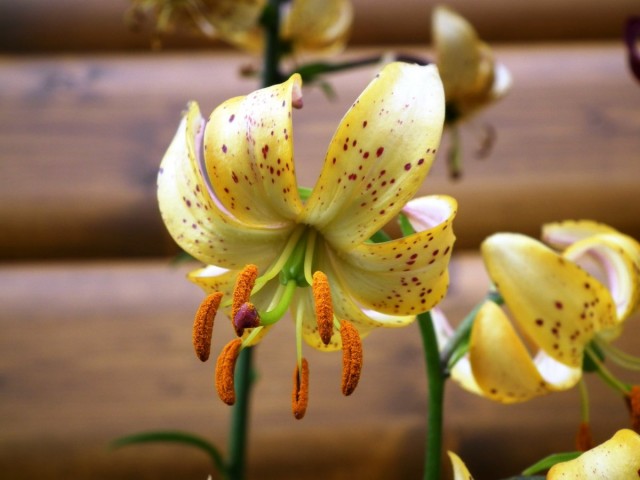 Lily ‘Mrs. R.O.Backhouse '. Group Martagon hybrids (Lilium ‘Mrs. R.O.Backhouse’. Martagon Hybrids). liliesandchillies
Lily ‘Mrs. R.O.Backhouse '. Group Martagon hybrids (Lilium ‘Mrs. R.O.Backhouse’. Martagon Hybrids). liliesandchillies
A distinctive feature of OT hybrids is that the bulbs are dark red, dark cherry, reddish brown. They are characterized by high frost resistance, a variety of colors, large flowers (about 30 cm in diameter) and, finally, the smell - it is more delicate, not as suffocating as in tubular ones. The varieties Dallas, Shocking, Orania, Conca d'Or, Robina have another advantage over the eastern ones - they prefer a soil with less acidity, do not get sick with fusarium, and botrytis is not observed.
OA-hybrids are still few, they do not differ in a variety of colors - orange-red with bronze, yellow, white borders: Fest Crown, Elegant, etc.
LO hybrids turned out to be no worse than those previously described. What is the Triumphant variety worth (this spring it made me happy, sprouted simultaneously with the first Asian lilies that appeared)! Worthy of admiration are the varieties Wile Treasure, Sea Treasure, Queen Promis, Prince Promis.
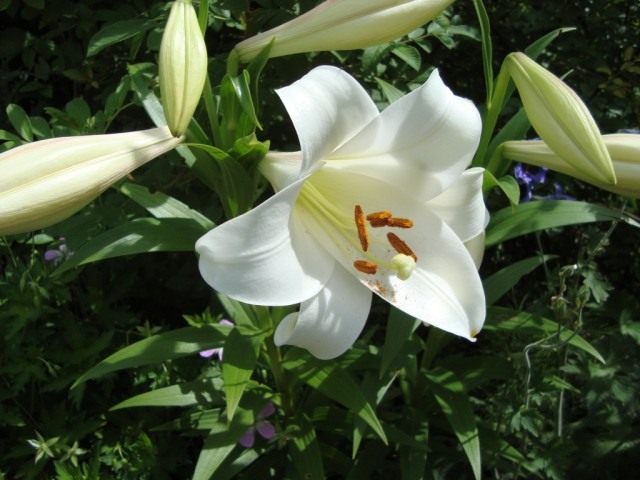 Lilia is ‘Zanlotriumph’, in Russia it is more often found as “Triumphant” or ‘White Triumphator’. Group Martagon hybrids (Lilium 'Zanlotriumph'. LO-hybrids). Uleli
Lilia is ‘Zanlotriumph’, in Russia it is more often found as “Triumphant” or ‘White Triumphator’. Group Martagon hybrids (Lilium 'Zanlotriumph'. LO-hybrids). Uleli
LOO-hybrids are the latest in breeding. They sprout together with the last dino-flowered and oriental ones. But the flowers are huge "plafonds" up to 40 cm in diameter! The whites are very good: Bourbon Diamond and Misting Diamond. They need to be covered with a thicker layer of mulching materials - 20-30 cm and protected from return frost with a film.
So, dry soil in the fall, non-buried planting, shelter with mulching materials for the winter make it possible to contemplate these beautiful flowers in the middle lane. And many of them bloom in more northern latitudes - Karelia, Murmansk and Arkhangelsk regions, beyond the Urals and Baikal.
Selecting varieties with different flowering times will expand the flowering range of lilies in your garden from July to mid-September. However, keep in mind that at least a month must pass from flowering to ripening of the bulbs, otherwise they will go weakened in winter, and the probability of overwintering will sharply decrease, and they may not bloom.
The article uses materials from Ponomarev Yu.P.
Tree lily plants
Naturally, these are not trees. These lilies do not have a trunk, which is woody, and in the southern regions they generally die in the winter season. So why then tree-like? They are connected with a tree only by a huge growth, which flowers do not have. In the Ural and Moscow region, plants may not grow to 2.5 m, even if you take care of them too much.Flowers can reach this height only in the south of our homeland.
In middle latitudes, lilies grow up to 1.5-1.7 m, which is also very good.
Moreover, special agricultural technology is not needed, and plus the plants have excellent winter tolerance.
Some tubular varieties can also grow to the size of a giant.
Varieties: Debbie, Labrador, Manissa, Purple Prince, Sucinto, Empoli.
Varieties.
1. LA - hybrids (abbreviation of the name from longiflorum asiatic) - hybrids resulting from the crossing of Asiatic and long-flowered lilies. Their fragrant flowers are larger (18-25 cm in diameter) than those of Asiatic lilies, while the petals and peduncles are less fragile. The color of flowers can be very varied and unusual: from snow-white to purple-burgundy, with all sorts of shade transitions. And some varieties of lilies from group of LA hybrids and can altogether change the color of flowers depending on age.
In addition, LA hybrids are unpretentious in cultivation, they reproduce easily.
Large and beautiful LA hybrids are versatile in use. They perfectly decorate gardens and parks, are easy to distill and look great when cut (do not fade for 10-14 days).
The most persistent and effective varieties from the LA hybrids group:
- Top Gun, Samur - pink flowers with a white center;
- Indian Diamond, Daytona - orange flowers;
- Fray, Golden State - yellow flowers;
- Original Live - red flowers;
- Ercolano - white and lemon flowers;
- California - cherry blossoms
- Bright Diamond - white flowers
Top Gun, Samur
2. OT - hybrids, or orientpets
Black Beauty
(short for oriental trumpet) - hybrids resulting from the crossing of oriental and tubular lilies. First grade (Black Beauty). This lily grows up to 2 m in height and on one sturdy stem can withstand many large (20-25 cm in diameter) fragrant flowers of dark cherry color. The spectacular Black Beauty lily is still grown in many countries, and it seems that she does not intend to give up positions. Lilies of this group are also distinguished by a huge variety of flower colors, they grow well, many of them reproduce easily (they share themselves and grow many children) and winter well in the middle lane with light shelter. Ot-hybrids get sick less often than lilies of other groups, but sometimes they are affected by a viral mosaic.
Popular varieties from the group of OT hybrids:
- Sheherazade - dark red flowers with a white-yellowish edge and a white-green throat;
- Georgetta - yellow flowers
- Honeymoon - pale yellow flowers
- Northern Carillon - large drooping flowers of a beet-purple tone with a white or pink border;
- Yelloween - light yellow flowers with white edges of the petals;
- Shocking - bright red flowers with a wide yellow border.
Northern carillon
Kaveri
3. OA - hybrids. There are few varieties in this group due to the difficulties of hybridization. OA hybrids took their beauty from orientals (although they have a smaller flower - only 15 cm in diameter), and their resistance - from Asians, so they can grow well in the middle lane. Bloom in late July - August. But it is worth noting the Kaveri variety, in which the raspberry color of the center turns to red-orange, and at the tips it becomes amber-yellow.
4. LO - hybrids or longipets. They are distinguished by rather large fragrant funnel-shaped flowers, white or pink in color. The group is rather small.
Most often, several varieties of LO are grown - hybrids:
- Triumphator;
- Prince Promise;
- Queen's Promise;
- Sea Treasure.
Prince promise
Planted in a sunny place or in partial shade. They prefer fertile, neutral or slightly acidic soils. Bulbs do not tolerate stagnant moisture; dry shelter is required for the winter.
Terry lilies: varieties with photos and names
Currently, there are a huge number of beautiful double Asian lilies. They are resistant to the winter period, unpretentious to care, they can be cultivated almost throughout the entire Russian territory.
Variety "Aphrodite".
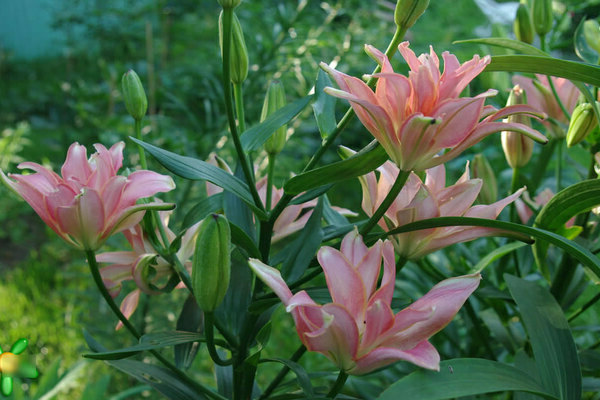
The growth of this flower is 1.1 m, the bud opens at the base by 15-18 cm. The average stem forms about 8 flowers, under more favorable conditions there can be 20 flowers. Moreover, the bush can be 0.5 m wide.
Variety "Aaron".
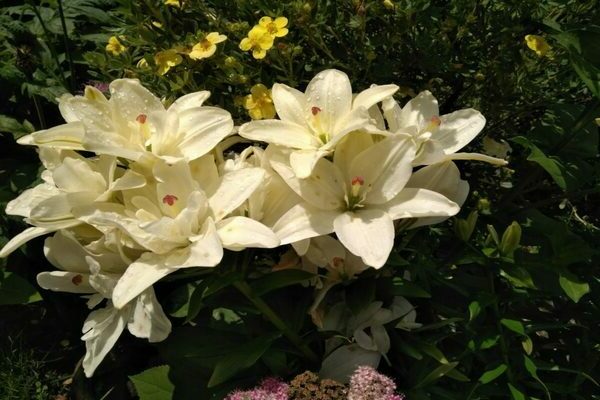
The stem is of average height - 70-80 cm, bears large double flowers of snow-white coloration. Flowering occurs in June and July.
Sphinx variety.
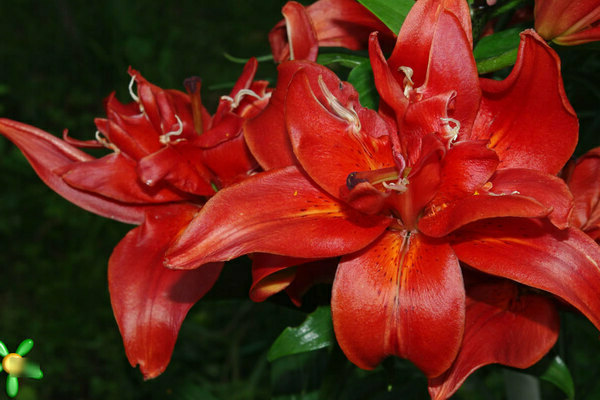
The growth of the stem is 1.1 m. There are erect, deep-red colored double flowers on it, their diameter is 15-18 cm. Flowering occurs in June-July.
Fata Morgana variety.
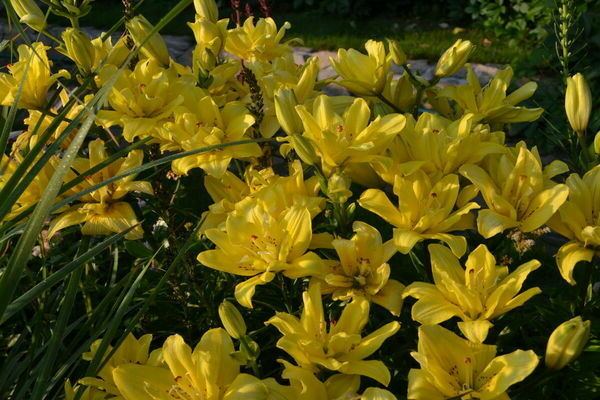
Flowers of solar coloration are pleasing to the eye. Flowering occurs in July-August. Stem growth - 90-95 cm.
Variety "Double Sense".
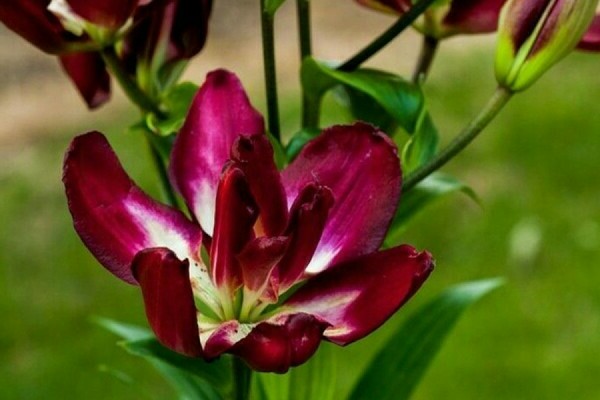
The petals of this variety are both double and bicolor. The flowers are medium in size. Flowering occurs in July-August.
Elodie grade.

Terry flowers. Height - 45-50 cm, active flowering, a lot of ovaries.
Variety "Mystery Dream".
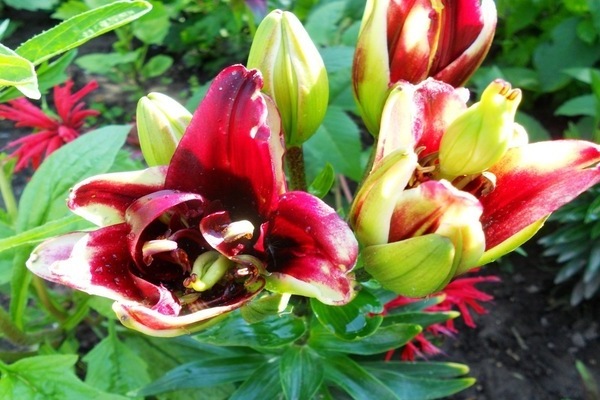
Terry flowers, light green in color, have dark specks in the central part. Double flowers become in the second year of life. The layers of the flower unfold gradually, every day you can see a new variety of the flower.
Varieties of lilies with names: the main international classification of lilies
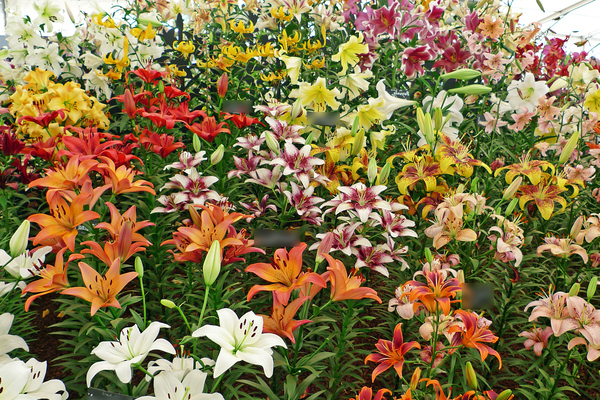
Varieties of lilies with names: the main international classification of lilies
At the end of the 20th century, the total number of lily varieties numbered ten thousand, another 200-300 varieties are added annually. How are new species obtained? Hybrids are crossed with each other or with pure varieties. Since lilies had and have strong differences with each other in how to care for them and for other reasons, in the middle of the 20th century they adopted the international classification of lilies, with some amendments that have come down to us.
Classification.
Asian hybrid varieties.
Curly lilies.
Snow white varieties.
American varieties.
Long-flowered lilies.
Tubular and Orleans varieties.
Oriental lilies.
Interspecific hybrid varieties.
Wild lilies.
The rest are hybrid varieties.
Flower growers often come up with their own classifications. Common classifications: by color of flowers, by the growth of stems, by the structure of the flower (there is terry or not), there is a scent or not, by resistance to frost, by the ways of reproduction.


